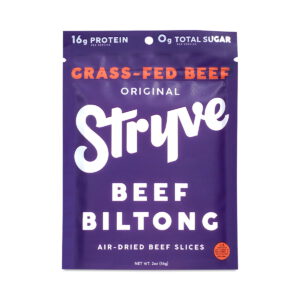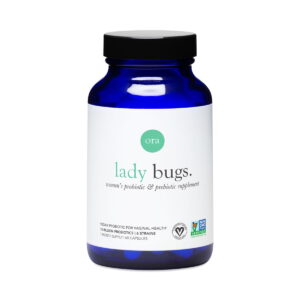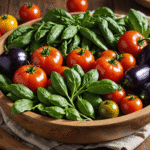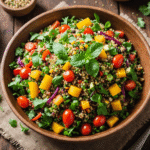- Healthy leftover meal ideas
- How to store leftovers properly
- Transforming proteins into new dishes
- Creative vegetable combinations
- Easy sauces and dressings for leftover meals
- Tips for maximizing flavor and nutrition
When embarking on your next grocery shopping trip, whether it is online or at your local market, keep your eyes peeled for a selection of ingredients that not only support your culinary creativity but also align with your health goals. First and foremost, focus on stocking up on fresh produce. Look for seasonal fruits and vegetables from local farms; these tend to be fresher, tastier, and often cheaper. Not only are they nutritionally rich, but they can yield a variety of easy recipes for utilizing your healthy leftovers.
Incorporate leafy greens such as spinach and kale, which are excellent for quick meals like smoothies and salads. Don’t forget about bell peppers, carrots, and cucumbers for crisp snacks or sliced additions to your leftovers. When buying canned or frozen vegetables, opt for those without added sugars or preservatives.
For proteins, lean meats (like chicken and turkey), fish, and plant-based options like tofu or tempeh should be your go-tos. If you’re looking for budget-friendly choices, consider canned beans or lentils, which are versatile and excellent sources of plant protein. While shopping, make sure to check for organic labels if you’re aiming for high-quality ingredients that minimize exposure to harmful pesticides.
When it comes to grains, opt for whole grains such as quinoa, brown rice, and whole wheat pasta. These are not only filling but provide significant nutritional benefits compared to their refined counterparts. Always check the packaging for expiration dates, and consider stocking up on frozen varieties that last longer and often contain comparable nutrients to fresh.
This is also a critical time to incorporate budget-friendly snacks into your cart. Items like popcorn, nuts, and seeds are great for quick energy boosts and can be used as toppings for oatmeal or yogurt for a hearty breakfast using your leftovers.
For safety while shopping, whether in-store or online, be on the lookout for food labels that ensure quality. Always check for recalls on products you’re considering purchasing, especially when buying online. Reputable retailers will have clear return policies and customer service options in case of issues with your order.
Finally, when shopping online, ensure the website is secure by looking for HTTPS in the URL and read customer reviews. This not only helps to ensure the products meet your expectations but also protects your personal information.
With careful planning and a keen eye, grocery shopping can become a breeze, leading to a rich variety of healthy leftovers and creative dishes that your family will love!
How to store leftovers properly
To maximize the shelf life and safety of your healthy leftovers, it’s essential to follow specific storage guidelines. Properly storing leftover food not only prevents spoilage but also helps retain its nutritional value and flavor, making it easier to create enjoyable meals quickly.
First, ensure that leftovers are cooled to room temperature before storing them. This step is crucial as placing hot food directly into the refrigerator can raise the overall temperature, potentially leading to bacterial growth. Food should be cooled within two hours of cooking. Once cooled, transfer leftovers into airtight containers designed for food storage. Glass or plastic containers with tight-fitting lids are great options, as they help maintain moisture and prevent contamination.
Labeling is another vital practice. Use a marker to write the date of storage on each container. This will help you keep track of how long the leftovers have been in the fridge. Most cooked foods are safe for consumption within three to four days when stored at 40°F (4°C) or below. For longer storage, consider freezing your leftovers. Foods kept in the freezer can last anywhere from two to six months, depending on the type. Remember to use freezer-safe containers or bags, and be sure to eliminate as much air as possible to prevent freezer burn.
Here’s a quick comparison of storage tips for different types of food:
| Food Type | Refrigerator Storage | Freezer Storage |
|---|---|---|
| Cooked Meats (chicken, beef, etc.) | 3-4 days | 2-6 months |
| Cooked Grains (rice, quinoa, etc.) | 3-5 days | 1-2 months |
| Cooked Vegetables | 3-7 days | 10-12 months |
| Soups and Stews | 3-4 days | 2-3 months |
| Cooked Pasta | 3-5 days | 1-2 months |
For reheating leftovers, be sure to bring the food to an internal temperature of 165°F (74°C) to ensure any potentially harmful bacteria are killed. Use a microwave, stovetop, or oven for reheating, but avoid reheating food more than once to minimize the risk of foodborne illnesses.
By following these fundamental storage practices, you can create a seamless and safe pathway to transforming your healthy leftovers into quick meals. This not only contributes to a waste-free kitchen but also facilitates easy recipes that you can whip up in no time, filled with flavor and nutrition.
Transforming proteins into new dishes
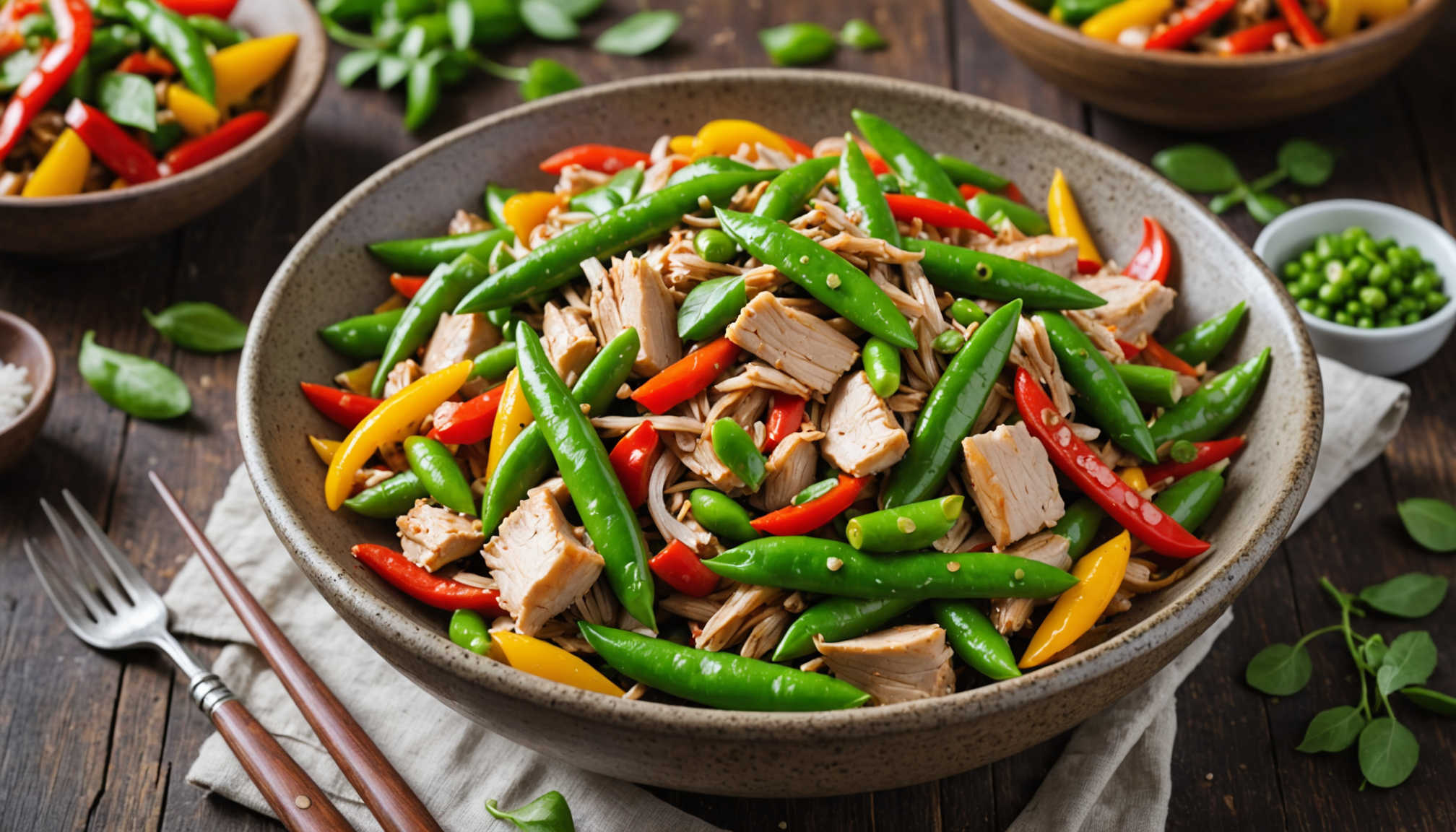
Transforming leftover proteins into new, delicious dishes is a fantastic way to minimize waste while maximizing flavor. Whether it’s grilled chicken, roasted tofu, or even leftover fish, there are endless possibilities when it comes to reinventing your leftover proteins into something fresh and exciting.
Start by shredding or chopping your cooked proteins into smaller pieces. This will allow them to blend seamlessly into a variety of dishes. For instance, leftover chicken can be easily mixed into a hearty salad, integrated into a wrap, or combined with whole grains for a filling bowl. Think outside the box: turning existing proteins into savory tacos with some added spices and fresh toppings can take your meals to another level.
- For chicken or turkey, create a quick and easy stir-fry by adding colorful vegetables like bell peppers and snow peas. Toss everything in a low-sodium soy sauce or a homemade ginger-garlic dressing for a nutritious boost.
- If you have leftover fish, consider transforming it into a flavorful fishcake. Mix the fish with breadcrumbs, herbs, and spices, then pan-fry for a fantastic meal that’s packed with protein.
- With leftover steak or other meats, try making a scrumptious curry. Use coconut milk and your choice of vegetables to create a rich and creamy dish that can be served over rice or with whole grain naan.
- For plant-based proteins like beans or lentils, mash them up to make burgers or patties. This not only gives them a new life but also introduces more plant nutrients into your diet.
To keep meals both healthy and budget-friendly, look for ways to utilize pantry staples in conjunction with your leftover proteins. Whole grains such as brown rice, quinoa, or farro are ideal bases that will enhance your dish’s nutritional profile. Combine grains with your leftover proteins, fresh veggies, and a homemade dressing for satisfying grain bowls.
Don’t overlook the power of spices and herbs to elevate leftover proteins. Fresh cilantro, basil, or a sprinkle of cumin can completely change the flavor profile, making the dish feel new and exciting. Consider what flavors complement the protein you have; for example, an Italian-inspired dish can be easily crafted with leftover chicken, adding sun-dried tomatoes, olives, and parsley.
Safety tip: When using leftover proteins, ensure they are stored correctly and consumed within the recommended timeframe. Always check for signs of spoilage before using leftovers in new dishes. When reheating, heat your leftovers to an internal temperature of 165°F (74°C) to ensure they’re safe to eat.
By creatively repurposing your proteins, you can enjoy quick meals without the hassle of starting from scratch. These easy recipes not only save time but also align perfectly with a healthy lifestyle, reducing food waste while still providing delicious options for your family to enjoy!
Creative vegetable combinations
Combining leftover vegetables into new, exciting dishes can greatly enhance your meals while minimizing waste. The versatility of vegetables means they can be easily transformed into numerous culinary delights. Start by thinking of classic combinations; for example, roasted carrots, bell peppers, and zucchini can be tossed together to create a vibrant vegetable medley. This mix can serve as a side dish, a salad topping, or even a hearty filling for burritos or wraps.
Another creative approach is to incorporate leftover vegetables into soups and stews. Simply chop or dice your remnants and add them to a simmering broth. Ingredients such as tomatoes, spinach, and carrots can elevate simple soups, adding flavor and nutrients. If you have leftover vegetables from a stir-fry, consider blending them into a creamy soup with a base of low-sodium vegetable broth and a dash of your favorite spices.
“Cooking is like love. It should be entered into with abandon or not at all.” – Harriet Van Horne
You can also turn leftover veggies into frittatas or omelets for a quick and easy breakfast or lunch. Whisk together eggs and pour them over sautéed vegetables in a skillet for a nutritious meal that can be prepared in minutes. Add a sprinkle of cheese or fresh herbs to give it a delightful twist.
For those with a penchant for snacking, consider blending leftover raw veggies into a refreshing dip or spread. Things like carrots, cauliflower, and bell peppers can be transformed into a vibrant hummus base, perfect for dipping or spreading on whole grain crackers. This serves not only as a tasty snack but also a method of sneakily incorporating more vegetables into your diet.
If you have an array of colorful veggies, think about making a vegetable stir-fry, which is perfect for a quick dinner. Toss your leftover vegetables in a hot pan with a little oil and your choice of protein. Don’t forget to season generously with soy sauce, garlic, and ginger for added depth of flavor. Serve it over brown rice or quinoa for a complete meal packed with nutrients.
Experimenting with vegetable combinations isn’t just about using what’s left over but also about embracing seasonal varieties. Consider a seasonal ratatouille made with zucchini, eggplant, and tomatoes, or a stuffed bell pepper filled with a mix of grains, beans, and cheese, allowing you to taste the uniqueness of each ingredient.
Mixing up your leftover vegetables not only opens the door to new flavor profiles but also encourages creativity in the kitchen. By utilizing what you have on hand, you can whip up easy recipes that are both delicious and nourishing, reinforcing a habit of reducing kitchen waste while enjoying satisfying quick meals.
Easy sauces and dressings for leftover meals
 Creating flavorful sauces and dressings from your pantry staples can easily elevate leftover meals to new culinary levels. A good sauce can transform ordinary ingredients and lend depth, with minimal effort required. Start with a base of high-quality oils or vinegars and add fresh herbs or spices to create delicious mixtures that enhance the flavor of your healthy leftovers.
Creating flavorful sauces and dressings from your pantry staples can easily elevate leftover meals to new culinary levels. A good sauce can transform ordinary ingredients and lend depth, with minimal effort required. Start with a base of high-quality oils or vinegars and add fresh herbs or spices to create delicious mixtures that enhance the flavor of your healthy leftovers.
For example, a simple vinaigrette can be made from whisking together olive oil, balsamic vinegar, Dijon mustard, and honey. This versatile dressing works perfectly drizzled over a salad featuring leftover roasted vegetables or as a zesty marinade for grilled proteins. If you prefer a creamy texture, try a base of Greek yogurt mixed with lemon juice, garlic, and fresh dill. This addition can turn your leftover grilled chicken into a delightful wrap or sandwich spread.
When preparing sauces, consider engaging your senses. Think about the aromas, colors, and textures of the ingredients you’re using. A homemade salsa made from fresh tomatoes, onion, cilantro, and lime juice can add a refreshing zing to leftover tacos or grain bowls. Additionally, blending sun-dried tomatoes into a sauce with nuts and garlic creates a rich, sun-kissed addition to any pasta or vegetable dish, making it feel gourmet in just a few minutes.
Don’t underestimate the power of simplicity; sometimes just a drizzle of sesame oil with a pinch of sea salt over steamed asparagus can make a nutritious side dish sing. Experimenting with global flavors can also be exciting: try a tahini-based sauce with garlic and lemon for a Middle Eastern flair, or a spicy ginger-soy sauce to give your fried rice a kick.
As you create your sauces, think about texture and balance. A tart sauce might pair perfectly with rich, creamy elements. Consider blending peanut butter with soy sauce and lime for a quick dip that can complement leftover grilled chicken skewers. This kind of innovation enriches your meals while being time-efficient.
If you’re ever unsure, remember that tasting as you go is key. It allows you to adjust flavors and ensure that the sauce perfectly complements your leftovers. The beauty of sauces is in their adaptability—use what you have and let it inspire new combinations.
- What are some easy sauce recipes for leftovers?
- Simple sauces can be made by mixing olive oil, vinegar, and herbs, or combining Greek yogurt with spices for a creamy dressing. A quick peanut sauce can also add flavor and depth to various proteins and vegetables.
- How do I prevent sauces from being too salty?
- Start with the recommended amount of salt and taste as you go. If you find the sauce is too salty, you can balance it by adding ingredients like lemon juice, vinegar, or sugar to offset the flavor.
- Can sauces be made in advance?
- Absolutely! Many sauces can be made ahead of time and stored in the refrigerator for several days. Just make sure to store them in airtight containers, and stir again before use to ensure even consistency.
- What are some unique ingredients I can add to sauces?
- You can use ingredients like nut butters, miso paste, and fruit purees to add unique flavors to your sauces. Experimenting with freshly grated ginger or garlic can also enhance their complexity.
- How should I store leftover sauces?
- Store leftover sauces in airtight containers in the refrigerator. Most homemade sauces can last for about a week, but always check for signs of spoilage such as unusual odor or separation.
- What types of dishes go well with homemade sauces?
- Homemade sauces can complement salads, grilled meats, pasta, rice dishes, and roasted vegetables beautifully. They can also enhance wraps and sandwiches, adding flavor and moisture.
- Can I freeze sauces for later use?
- Yes, many sauces can be frozen for future use. Just ensure they are stored in freezer-safe containers, leaving some space for expansion as they freeze. Thaw them overnight in the refrigerator before using.
Tips for maximizing flavor and nutrition
Maximizing flavor and nutrition in your meals often begins at the grocery store, where careful selection of ingredients can make all the difference. While shopping, prioritize items that pack a nutritional punch and are versatile in your kitchen. Consider switching to organic options for produce that you consume frequently, such as strawberries or spinach, to minimize pesticide exposure, as these are often found to carry higher pesticide residues. If you’re shopping on a budget, keep an eye out for local farmer’s markets where you can often find fresh, seasonal produce at competitive prices. Not only is this a great way to support local agriculture, but seasonal fruits and vegetables are typically more flavorful and nutrient-dense.
As you assemble your grocery list, make room for nutrient-rich pantry staples. Items like canned tomatoes, beans, and lentils can enhance your meals while ensuring you utilize your leftovers effectively. If you love experimenting in the kitchen, try to include a variety of spices and herbs that can be incorporated into numerous dishes, adding both flavor and health benefits. For example, turmeric and cumin not only bring depth to savory dishes but also offer anti-inflammatory properties, making them excellent companions for your healthy leftover meals.
When it comes to healthy grains, opt for options such as quinoa, farro, or brown rice, which provide essential nutrients and fibers that enhance your overall health. Not only do these grains serve as robust bases for reflections of your culinary creativity, but they can also easily absorb the flavors of sauces and dressings you prepare. Pairing whole grains with colorful vegetables creates vibrant and nutritious meals that bring various nutrients to your table.
If you’re on a fitness journey, consider stocking up on protein-rich foods like lean meats, fish, eggs, or plant-based proteins such as chickpeas and firm tofu. A balanced intake of protein is vital for muscle recovery and overall health. When shopping for fish, look for sustainability labels to ensure you are making environmentally friendly choices. Keep an eye out for less expensive cuts of meat or larger packs that can be portioned and frozen for later use—this can significantly cut down on costs.
Another important consideration when grocery shopping, whether in-person or online, is the sourcing of ingredients. Reach out to local farms or community-supported agriculture (CSA) programs. This not only guarantees ultra-fresh products but tends to be more affordable than conventional supermarket prices. Online shopping should also involve purchasing from reputable websites known for delivering high-quality products, ensuring that food safety practices are in place.
Lastly, keep safety in mind. If you are purchasing items online, only use secure websites. Look for HTTPS in the URL and read customer reviews. This ensures that your personal information remains safe and that you’re getting the quality you expect. Checking labels for expiry dates, especially for perishables, is also crucial to avoid the risk of consuming outdated products.
With these practical tips in hand, you can enhance your grocery shopping experience, ensuring that you fill your cart with nutritious ingredients that will help you create delicious, easy recipes with your healthy leftovers. Enjoy the process, get creative, and transform your meals into quick options that your whole family will love!
New Customers Offer!
Free Gift for the new customer
$24 Value, When You Subscrib Visit Thrive Market

